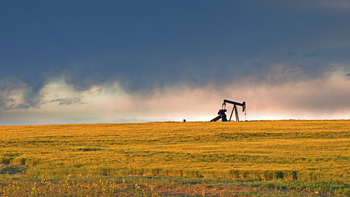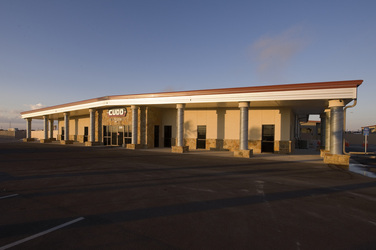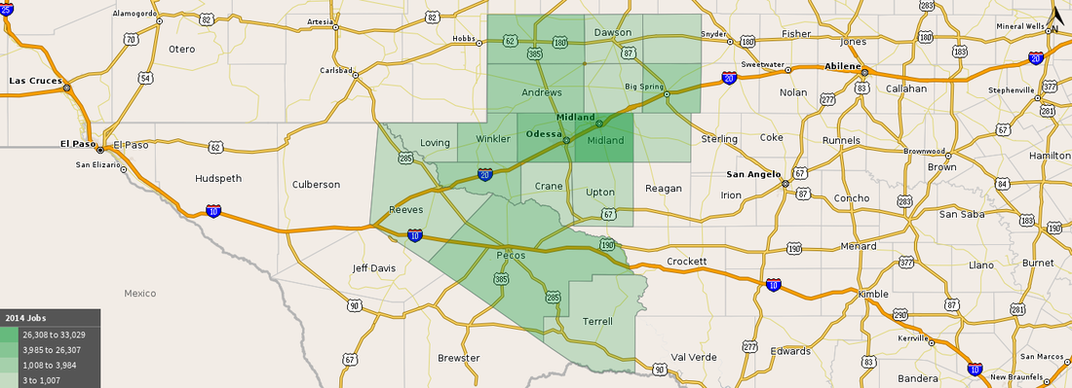"The Permian Basin’s oil and gas industry is an important driver of economic activity in the region and beyond. The industry’s activities generate and sustain jobs, income, output, and provide substantially to the gross state products of both Texas and New Mexico."
- 2014 Texas Tech University Economic Impact Study of the Permian Basin's Oil & Gas Industry

Fossil Fuel: Fossil Fuel Production (primarily Oil and Gas Production) has long been the foundation of the Permian Basin regional economy.
Renewable Energy/Environmental Technologies: Renewable energy is defined by the Texas Renewable Energy Industry Association (TREIA) as “any energy resource that is naturally regenerated over a short time scale and derived directly from the sun (such as thermal, photochemical, and photoelectric), indirectly from the sun (such as wind, hydropower, and photosynthetic energy stored in biomass), or from other natural movements and mechanisms of the environment (such as geothermal and tidal energy).”
Green technology is generally defined as “a means of energy production that is less harmful to the environment than more traditional ways of generating energy, such as burning fossil fuels.” Defining green technology in this way is consistent with the Bureau of Labor Statistics definition of green jobs (jobs in the green technology industry) as those involved in “making production processes more environmentally friendly or use fewer natural resources.”
Expansion of natural gas exploration, improvement in production techniques, such as fracking and horizontal drilling, and improved transmission capabilities for renewable energy (wind and solar farms) due to the CREZ promise to continue to grow the regional competency in Energy for decades to come.
The industry group that comprises the cluster includes.
Renewable Energy/Environmental Technologies: Renewable energy is defined by the Texas Renewable Energy Industry Association (TREIA) as “any energy resource that is naturally regenerated over a short time scale and derived directly from the sun (such as thermal, photochemical, and photoelectric), indirectly from the sun (such as wind, hydropower, and photosynthetic energy stored in biomass), or from other natural movements and mechanisms of the environment (such as geothermal and tidal energy).”
Green technology is generally defined as “a means of energy production that is less harmful to the environment than more traditional ways of generating energy, such as burning fossil fuels.” Defining green technology in this way is consistent with the Bureau of Labor Statistics definition of green jobs (jobs in the green technology industry) as those involved in “making production processes more environmentally friendly or use fewer natural resources.”
Expansion of natural gas exploration, improvement in production techniques, such as fracking and horizontal drilling, and improved transmission capabilities for renewable energy (wind and solar farms) due to the CREZ promise to continue to grow the regional competency in Energy for decades to come.
The industry group that comprises the cluster includes.
Economic Impact

- 2942 Establishments in the region
- 5.20 Jobs Multiplier
- 82.3% of Jobs are held by males
Industry Requirements: Industry / Amount / In-Region / Out of Region
Crude Petroleum and Natural Gas Extraction / $1,494,612,354 / 47.7% / 52.3%
Corporate, Subsidiary, and Regional Managing Offices / $473,727,599 / 13.6% / 86.4%
Petroleum Refineries / $338,106,969 / 69.8% / 30.2%
Support Activities for Oil and Gas Operations / $263,932,365 / 96.9% / 3.1%
Offices of Lawyers / $203,712,902 / 35.7% / 64.3%
Oil and Gas Production:
According to a 2014 Texas Tech University Economic Impact Study of the Permian Basin's Oil & Gas Industry, the Texas Portion of the Permian Basin’s oil and gas industry:
- Sustains over 444,000 jobs
- Generates $113.6 billion in economic output
- Contributes more than $60.2 billion to the Gross State Product of TexasFort Stockton - Pecos County
Drilling Activity and Production is an important factor in providing current and future economic benefits:
- Permian Basin has the greatest rig count of any basin/region in the world (27% of the U.S. and 56% of Texas)
- A rapidly increasing amount of Permian Basin wells being drilled are horizontal (Since December 27, 2013, the number of horizontal, oil-directed rigs in the Permian Basin rose by 63, representing half of the total increase of those types of rigs in the United States)
- Permian Basin well productivity has improved dramatically since 2011 due to improved technology in horizontal drilling and multi-stage hydraulic fracturing
- Drilling efficiencies are being realized in all U.S. Resource Plays and the Permian Basin is the least mature, thus vast efficiency improvements are expected in the Permian Basin
Note: While the region isn’t congruous to the 17-County PBRPC planning region, the Texas Portion of the Permian Basin as defined in the 2014 Texas Tech University Economic Impact Study of the Permian Basin's Oil & Gas Industry is an effective proxy for the region.
Wind Energy:
In 2010, wind power generated electricity in 38 states across the country, with overall rated capacity at more than 40,000 MW, and Texas is at the forefront of the wind energy revolution. Texas was the first state to reach the 10,000 MW nameplate capacity limit, with more installed capacity planned for the near future. No area has a larger impact on this form of clean energy than West Texas, which is currently home to the six largest wind farms in the United States. According to Texas Tech University Health Science Center's F. Marie Hall Institute for Rural Health, West Texas (proxy for the Permian Basin region), accounts for 91.7% of wind energy produced in Texas. The installed capacity in the region currently has the potential to power between two and three million average homes a year.
- 5.20 Jobs Multiplier
- 82.3% of Jobs are held by males
Industry Requirements: Industry / Amount / In-Region / Out of Region
Crude Petroleum and Natural Gas Extraction / $1,494,612,354 / 47.7% / 52.3%
Corporate, Subsidiary, and Regional Managing Offices / $473,727,599 / 13.6% / 86.4%
Petroleum Refineries / $338,106,969 / 69.8% / 30.2%
Support Activities for Oil and Gas Operations / $263,932,365 / 96.9% / 3.1%
Offices of Lawyers / $203,712,902 / 35.7% / 64.3%
Oil and Gas Production:
According to a 2014 Texas Tech University Economic Impact Study of the Permian Basin's Oil & Gas Industry, the Texas Portion of the Permian Basin’s oil and gas industry:
- Sustains over 444,000 jobs
- Generates $113.6 billion in economic output
- Contributes more than $60.2 billion to the Gross State Product of TexasFort Stockton - Pecos County
Drilling Activity and Production is an important factor in providing current and future economic benefits:
- Permian Basin has the greatest rig count of any basin/region in the world (27% of the U.S. and 56% of Texas)
- A rapidly increasing amount of Permian Basin wells being drilled are horizontal (Since December 27, 2013, the number of horizontal, oil-directed rigs in the Permian Basin rose by 63, representing half of the total increase of those types of rigs in the United States)
- Permian Basin well productivity has improved dramatically since 2011 due to improved technology in horizontal drilling and multi-stage hydraulic fracturing
- Drilling efficiencies are being realized in all U.S. Resource Plays and the Permian Basin is the least mature, thus vast efficiency improvements are expected in the Permian Basin
Note: While the region isn’t congruous to the 17-County PBRPC planning region, the Texas Portion of the Permian Basin as defined in the 2014 Texas Tech University Economic Impact Study of the Permian Basin's Oil & Gas Industry is an effective proxy for the region.
Wind Energy:
In 2010, wind power generated electricity in 38 states across the country, with overall rated capacity at more than 40,000 MW, and Texas is at the forefront of the wind energy revolution. Texas was the first state to reach the 10,000 MW nameplate capacity limit, with more installed capacity planned for the near future. No area has a larger impact on this form of clean energy than West Texas, which is currently home to the six largest wind farms in the United States. According to Texas Tech University Health Science Center's F. Marie Hall Institute for Rural Health, West Texas (proxy for the Permian Basin region), accounts for 91.7% of wind energy produced in Texas. The installed capacity in the region currently has the potential to power between two and three million average homes a year.
Employment Outlook

In 2014, the region maintained an estimated 67,738 jobs in the Energy Cluster, more than four-times the national average for a typical region the size of Permian Basin. Employment is projected to grow 19.5% from 2014 to 2019 versus a projected 7.5% growth rate nationwide during the same timeframe. Average earnings for jobs in the cluster are approximately $96,986, 9.8% higher than the national average.
Within the cluster, the occupations with the highest concentration of jobs include:
- 5,744 Roustabouts, Oil & Gas
- 5,192 Service Unit Operators, Oil, Gas, & Mining
- 2,690 Heavy & Tractor Trailer Truck Drivers
- 2,300 First Line Supervisors (Construction Trades & Extraction)
Within the cluster, the occupations with the highest concentration of jobs include:
- 5,744 Roustabouts, Oil & Gas
- 5,192 Service Unit Operators, Oil, Gas, & Mining
- 2,690 Heavy & Tractor Trailer Truck Drivers
- 2,300 First Line Supervisors (Construction Trades & Extraction)
Economic Development Catalysts
Agrium Inc. gave final approval for a projected $720 million expansion for the Borger,
Texas nitrogen facility. The expansion will add over 670,000 tons of new urea
production annually. Over 110,000 tons of Diesel Emission Fuel (DEF) grade
urea. The DEF product us used to reduce nitrogen oxide emission in diesel
vehicles.
Agrium is one of the largest and lowest-cost producers of nitrogen in the world.
The upgrade and expansion at the Borger facility will continue to grow Agrium’s
nitrogen footprint in the important agricultural region while providing a
strong return on investment. The construction will bring approximately 1,000 jobs during the construction phase and 30 additional full time jobs when the facility goes on line in
Mid 2015. The job count for full time contractors at the plant will increase,
not to mention the jobs created in truck and rail transportation when the
project is completed.
Midland partnered with Texas Tech University System with start-up funds for the formation of the National Institute for Renewable Energy (NIRE), an independent public-private collaboration that works to solve key scientific and technology challenges facing the wind power industry.
The City of Odessa Energy Complex on Interstate 20 has the capacity to host heavy manufacturing. Resources include Oncor and gas 345 KV power station, water supply, 24-hour Union Pacific operated freight center, natural gas, industrial waste treatment plant, and available surface space.
The City of Andrews has a new 190-acre Energy Park in the northeast portion of the town. The park offers build-to-suit programs and (conditional) free land available for qualified energy sector businesses.
Pecos County Commissioners approved a tax abatement in December 2014 for First Solar to build a second Pecos County solar electric generating station. The $170 million investment will create 200 temporary construction jobs and will be located in the Tunas Creek reinvestment zone. Construction will begin in January 2015 and transmission is expected to commence in January 2016. Projects such as this are indicative of a growing alternative energy competency for the region.
Midland partnered with Texas Tech University System with start-up funds for the formation of the National Institute for Renewable Energy (NIRE), an independent public-private collaboration that works to solve key scientific and technology challenges facing the wind power industry.
The City of Odessa Energy Complex on Interstate 20 has the capacity to host heavy manufacturing. Resources include Oncor and gas 345 KV power station, water supply, 24-hour Union Pacific operated freight center, natural gas, industrial waste treatment plant, and available surface space.
The City of Andrews has a new 190-acre Energy Park in the northeast portion of the town. The park offers build-to-suit programs and (conditional) free land available for qualified energy sector businesses.
Pecos County Commissioners approved a tax abatement in December 2014 for First Solar to build a second Pecos County solar electric generating station. The $170 million investment will create 200 temporary construction jobs and will be located in the Tunas Creek reinvestment zone. Construction will begin in January 2015 and transmission is expected to commence in January 2016. Projects such as this are indicative of a growing alternative energy competency for the region.

The Competitive Renewable Energy Zones (CREZ) power transmission project has increased the amount of wind power that can be transmitted from West Texas wind farms to the eastern portions of Texas. The estimated $7 billion project paid for by adding fees to Texans' utility bills. The CREZ, whose construction was largely completed in 2013, is resulting in fewer curtailments of wind power and more even prices in Texas’ energy market, and opens the possibility of more wind and solar projects in the Permian Basin.
First Solar made a significant investment in solar energy with the Barilla Project, a 30-megawatt solar farm in 2014. The 20-acre project sits in Pecos County.
West Texas will soon be home to the state's largest solar farm, a 150-MW Recurrent Energy facility to be completed in 2016, as a result of an energy purchasing agreement with Austin Energy.
MORE COMING SOON...
First Solar made a significant investment in solar energy with the Barilla Project, a 30-megawatt solar farm in 2014. The 20-acre project sits in Pecos County.
West Texas will soon be home to the state's largest solar farm, a 150-MW Recurrent Energy facility to be completed in 2016, as a result of an energy purchasing agreement with Austin Energy.
MORE COMING SOON...

